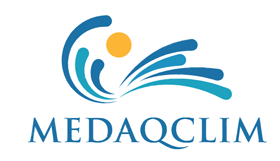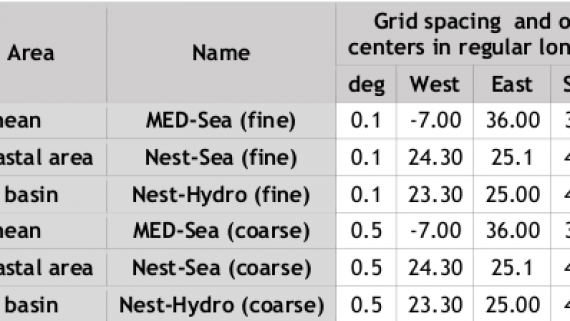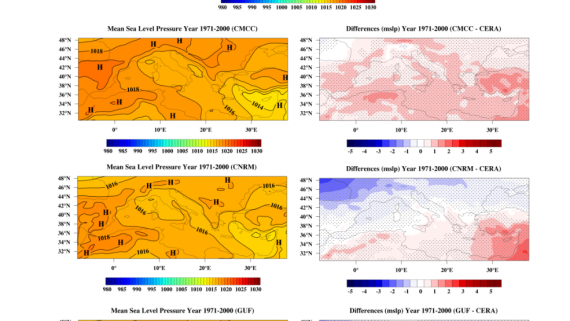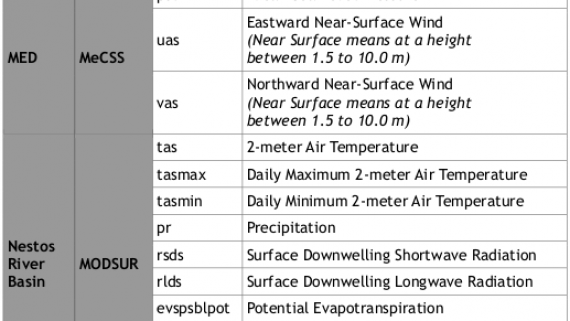Work Packages & Deliverables
MEDAQCLIM PROJECT WORK PACKAGES & DELIVERABLES
The WP1 with title Climate scenarios and assessment of RCM projections and the associated Deliverable D6 entitled Climate modelling tasks focused on:
- The selection, acquisition, management, and processing of a unified set of IPCC’s Climate Change data under different GHG concentration scenarios, namely RCP4.5 and RCP8.5, to be used as input in all hydrologic and hydrodynamic models in MEDAQCLIM Project.
- The evaluation of the selected datasets of climate variables led by thorough validation of modelled atmospheric parameters compared against re-analysis data and/or in situ observations together with basic statistical analysis.
- The presentation of estimated local/regional projections from RCM models gathered from databases published by national Euro-Mediterranean climate centers.
The WP2 entitled Integrated coastal water resources modelling under climate change uncertainty together with Deliverable D7 entitled Hydrological Modelling Tasks focused on:
- a further evaluation of the selected datasets of climate variables used as input for hydrologic modelling led by thorough validation and bias-correction of modelled atmospheric parameters (only precipitation and temperature) compared against in situ observations via statistical analysis.
- The setup, validation, calibration, and parametric fine-tuning of the hydrologic and maritime hydrodynamic models MODSUR and MeCSS, respectively. Model evaluations were based on comparisons of simulation outputs against in situ observations of hydrographic features (e.g. runoff and coastal sea levels).
- The integrated coastal water resources modelling under climate change uncertainty that comprises separate hydrological and maritime hydrodynamic modelling, combination of model results, and production of plausible estimations for rainfall-run-off, river flow rates and discharges, coastal barotropic currents and SSH fields, under the influence of CC effects.
Within the WP3 Integrated modelling of surface-subsurface and water-plant-soil-atmosphere interactions under climate change and the related Deliverable D9 entitled Optimization/socio-economic modelling tasks, the conducted work focused on:
- Agricultural drought assessment and indicators, while aiming at setting up an operational tool to identify indicators at different scales that reflect critical processes or state variables related to the integrity and sustainability of the use of water resources. The most important issue that was investigated is the assessment of drought.
- Coupled modelling of coastal hydrodynamics to littoral inundation, and hydropower dam operation to an irrigated agriculture network considering several surface waters processes and plant-atmosphere interactions. The modelling of the full feedback mechanism with the water use continuum is essential to capture the entire dynamics of water exchanges between the coast, the river, the infrastructure, the farming land, and the atmosphere. The role of vegetation in water usage was defined to correctly evaluate management scenarios. Model outputs were combined with downscaled precipitation estimations obtained from RCMs.
- Coupled hydrological and coastal inundation models. The aim of this task was to develop an integrated coastal zone modelling tool to assess the impacts of CC under different water policy and management decisions to coastal zones (given in WP4 and WP5). In this framework, a new tool for coastal flooding was proposed to simulate the main inundation processes at the coastal zone scale, with a fine enough resolution to treat the local lagoons, and the peculiarities of the deltaic system. Simultaneously, water balance estimations were also modelled considering integrated calculations of dam operation-related water use and larger-scale hydrological modelling components (from WP2) including water resources modelling with WEAP. Results were combined to form the conceptual integrated coastal zone management (ICZM) tool (in WP5) that combined all the available information to assess: a) water quantity in the deltaic system; b) agriculture productivity; and c) coastal inundation problems.
The WP4 entitled Applications to selected case studies: databases, GIS, numerical modelling, and socio-economic scenario and the associated Deliverable D11 entitled Water resources management models/scenarios contain all the simulation results for future climate conditions and in particular focused on:
- The description of the methodology for the developed scenarios and relevant case studies; the presentation of the 36 discrete cases that were finally developed; the analysis of the developed scenarios and case studies; the analysis of the assumptions that are used in the case studies development.
- The detailed presentation of the hydrologic simulation outputs in the water basin and the hydropower plants’ simulation for each case study scenario. In particular, the Deliverable clearly depicts:
- the outputs related to the reservoirs (storage elevation, duration curves and energy production),
- the outputs related to surface discharges (water volumes reaching the delta’s neck and the estuaries),
- the outputs related to the environmental flow, and
- the outputs related to agriculture (coverage of irrigation demands and water deficits).
- The thorough demonstration of coastal inundation modelling outputs under the effects of projected climate change, with emphasis given to:
- the sea level elevation and inundated areas differentiations under climate change (episodic storm surge maxima on the shoreline, coastal inundation areas, coastal inundation probabilities at vulnerable areas), and
- the coastal inundation areas and maps for all the referred case studies – scenarios.
- The outputs of heat stress assessment on specific agriculture crops for the entire period of simulations and for all the case studies and scenarios, with emphasis put to:
- the heat stress simulation outputs for maize production under RCP4.5 and RCP 8.5 in the short-term future period 2021-2050, and
- the heat stress simulation outputs for maize production under RCP4.5 and RCP 8.5 in the long-term future period 2071-2100.
The WP5 entitled Socio-Economic Vulnerability Assessment – From modelling to GIS mapping and the related Deliverable D12 entitled Socio-economic vulnerability maps focused on the mapping of deltaic vulnerability in the case study area with special emphasis on:
- The definition and analysis of the concepts related to vulnerability assessment, such as the hazard, capacity, risk, risk assessment and multi-risk assessment concepts.
- The development of a conceptual modeling framework to simulate and index the locally important processes in the coastal zone of Nestos river delta within an integrated risk assessment approach.
- The development of an index about climate change impact on deltaic areas, based on different scenarios of the various implemented model interactions. The developed Integrated Deltaic Risk Index (IDRI) consists of several discrete components, i.e. the Coastal Flood Risk Index (CFRI), the Water Scarcity Risk Index (WSRI) and the Heat Stress Risk Index (HSRI).
- The clear presentation of the results related to the CFRI, WSRI, HSRI, and IDRI in short- and long-term mode, under all the developed case studies.
- The analysis and mapping of the stakeholders within the study area and the final formulation of the CFRI, WSRI, HSRI, and IDRI considering stakeholders’ preferences, comments, proposals and answers to a specifically formulated questionnaire.
The WP6 entitled Management, reporting and dissemination and the associated Deliverable D13 entitled Management report present a synopsis of the management processes that were followed during the project implementation and focused on:
- The presentation of all Deliverables’ abstracts during the life cycle of the project.
- The demonstration of the appeared obstacles during the implementation process of the various WPs, as well as the adopted solutions to battle any shortcomings.
- The illustration of the scientific publications in journals and conference proceedings that were produced during the life cycle of the project.
- The synopsis of the process for stakeholders’ participation.






